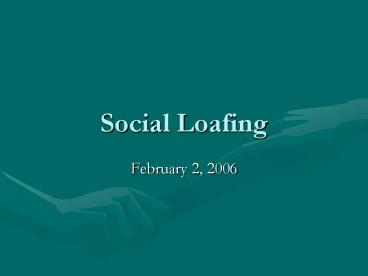Social Loafing - PowerPoint PPT Presentation
1 / 19
Title:
Social Loafing
Description:
Social Facilitation: ... Social facilitation occurs when people are working alone, but in ... How can we avert social loafing to make groups more productive? ... – PowerPoint PPT presentation
Number of Views:2840
Avg rating:3.0/5.0
Title: Social Loafing
1
Social Loafing
- February 2, 2006
2
Course Lectures Online
- Slides available on my website
- Go to the ILR homepage
- Click on the directory.
- Click on Jack Goncalo
- Click on Teaching
- Syllabus already posted
- Lecture slides posted after each class.
3
The Presence of Others Helps Or Does It?
- Social Facilitation
- The presence of an audience increases arousal
which facilitates performance on problems that
are well-learned and therefore simple, but
diminishes performance on tasks that are not
well-learned and therefore difficult. - Social facilitation occurs when people are
working alone, but in the presence of an audience.
4
Case of the rope pulling contest
- QUESTION Is social facilitation observed when
people are working as a member of a team? - Rope Pulling
- As you add more and more people to a group
pulling on a rope, the total force exerted by the
group rose, but the average force exerted by each
group member declined. (Ringlemann)
5
Social Loafing
- BASIC PRINCIPLE
- The larger the number of individuals whose work
is combined on a group task, the smaller is each
individuals contribution.
6
Social Loafing or Coordination Loss?
- Experimental Confound Problem may not be the
reduction of individual effort, but poor
coordination between members of the group. - Example People may pull the rope in different
directions at different times, so the group does
not capitalize on the efforts of each individual
member of the group. - Alternative explanation must be eliminated.
7
Ruling Out Coordination Loss
- Subjects made to think they were pulling
together, when in fact they were pulling alone. - Shouting together when actually shouting alone.
- Result Subjects reduced their task effort when
they were tricked into thinking that they were
working as a team when they were actually working
alone.
8
Counteracting the Tendency to Loaf
- How can we avert social loafing to make groups
more productive? - Identifiability People are motivated when they
believe that their work is identifiable and
separable from the work of others. - Divide tasks
- Assign roles
- Measure individual inputs
- Limit group size
9
Identifiability A few examples
- MOTIVATING TEAM PERFORMANCE
- People shout louder when each group member is
wearing a microphone and believe that their
personal output can be measured. - Football coaches individually film and evaluate
each player.
10
Cross-Cultural Differences
- Question Does social loafing occur more often in
individualistic or in collectivistic cultures? - Earley (1989) showed that
- American groups (individualistic) loafed more
than Chinese groups (collectivistic). - Accountability reduced loafing in American groups
but not in Chinese groups.
11
Group Brainstorming
- Shouting and rope-pulling are fun, but does
social loafing influence anything important? - Brainstorming
- Brainstorming groups are an important source of
creativity in organizations. - Goal of brainstorming to come up with as many
different ideas as possible in a set amount of
time. - Does social loafing occur in brainstorming groups?
12
Class Demonstration
- You were told to generate as many ideas for
re-doing the undergraduate lounge. - Group size was varied
- 1, 2, 4, 8, 12
- Prediction
- Total group output should increased with
increasing group size. - Number of ideas generated per person should
decrease with increasing group size.
13
Increasing Group Size, Increasing Group Output
14
But Decreasing Individual Input
15
Social Loafing?
- Did you limit your contribution to the group
discussion? Why or why not? - Where there people who contributed more ideas
than others? - Was there some expectation or goal for how many
ideas you should personally contribute to the
group? - Are there alternative explanations other than
social loafing?
16
Evaluation Apprehension
- Did you limit your contributions to the group
discussion because you worried that people would
judge your ideas? - OR,
- Did you limit your contribution to the group
discussion because you felt that no one was
paying any attention to how much you were
contributing?
17
Production Blocking
- Compared with working alone, individuals idea
generation is blocked while waiting their turn
to talk (everyone cant talk at once) and
listening to other people is distracting. - Did your group experience production blocking?
- Based on the individuals output, group
productivity should have been much higher.
18
From the individual to the group
19
Conclusions
- Are two heads better than one?
- Do you think group work is useful, or might
people be better off just working alone? - Are there any benefits to group brainstorming
that are not captured by measuring the sheer
number of ideas? - How would you design a brainstorming group given
what you know about social facilitation and
social loafing?































